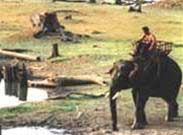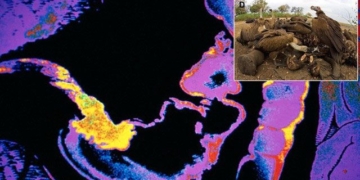As of now, the wild elephant population in Vietnam has dwindled to just 76 individuals. Scientists warn that if immediate protective measures are not taken, in 30 years, elephants will be absent from the forests of Vietnam.
Declining Numbers
 Elephants have been integral to the construction and protection of the country for thousands of years. However, it was only after the reunification of the country that we began to fully assess the elephant population.
Elephants have been integral to the construction and protection of the country for thousands of years. However, it was only after the reunification of the country that we began to fully assess the elephant population.
From 1975 to 1980, the estimated wild elephant population was around 1,500 to 2,000. They were distributed throughout the country and contributed to the biodiversity of Vietnam’s natural environment. However, since 1980, the elephant population has rapidly declined. Thousands of hectares of forests have been destroyed, leading to the destruction or reduction of their habitats. Elephants’ biological behaviors have been disrupted, significantly affecting their reproduction and population growth.
Moreover, the poaching of elephants for their ivory, skin, tusks, teeth, and bones has led to conflicts between elephants and humans. The illegal trafficking and transportation of wildlife, including elephants, to other countries across borders have increased, as elephant habitats are often located near border areas with Laos and Cambodia.
All these factors, combined with a diminishing generational richness, have led to the inevitable consequence that the elephant population not only fails to reproduce but is drastically decreasing. The number of elephants has plummeted from 1,500 in 1980 to just 400 in 1992, 250 in 1995, and 160 in 1997. Currently, the estimated population stands at 76.
The distribution areas have decreased by more than 50% over the past 30 years, with only 14 areas identified as having elephants. They live scattered in small groups and are constantly threatened with extinction.
Solitary Elephants – Causes and Consequences
The answer is almost obvious. According to statistics from scientists, elephants in Vietnam are concentrated in most provinces of the Central Highlands. Given the rate of deforestation, the decline in the number of elephants is inevitable. In just the first three months of this year, 70 hectares of forest were destroyed in Dong Nai and 59 hectares in Dak Nong. These areas are among the highest concentrations of elephants in Vietnam.
Their forest habitats, the eternal home of elephants, are being destroyed for forest resources and the benefits derived from elephants themselves. When their lives are threatened, elephants instinctively protect themselves: they move away from danger and are ready to attack anyone who poses a threat.
As of 2005, there were nine conflict zones out of a total of 14 areas where elephants are distributed. The most severe incidents occurred in Dong Nai province, where 12 people were killed from 1993 to 1998, and in Tan Linh (Binh Thuan), where 13 people lost their lives.
Surveys in areas known to have elephants reveal that they are gentle creatures and are very approachable by humans. Scientists agree with this observation. They can even approach humans but do not attack.
Mr. Tran Xuan Long, Head of the Phu Lai Ranger Station at Pù Mát National Park (Con Cuong District, Nghe An), stated: “There have been nights when we were on duty in the forest. At midnight, when we open the door of the hut, we might come face-to-face with an elephant walking by. When they sense movement, they immediately leave for another area.”
Thus, elephants are quite gentle and only become aggressive when their habitats are encroached upon. However, even in areas considered to be the least disturbed by human activity, Pù Mát National Park has recently witnessed phenomena that have raised concerns among scientists.
Mr. Nguyen Van Dien, Deputy Director of the national park, reported that at the end of March, a herd of four tuskless elephants was spotted moving through the forest, and a few days later, a solitary female elephant was seen in the vicinity of Kèm Falls. In some villages, elephants have been known to herd cattle.
At Pù Mát National Park, the author and forest management officials have witnessed traffic signs toppled by elephants along the road to Kèm Falls. Even fire danger signs have been bent by elephants. According to those familiar with the area, elephants have a strong aversion to metal, steel, and concrete, and they often uproot such materials whenever they encounter them.
The question arises whether this behavior is inherent to elephants or if they sense an impending danger. Notably, elephants have a particular fondness for banana roots and banana cores, which are often used as food by local residents. This might also explain why elephants damage traffic signs.
Urgently Establish “Peaceful Shelters”
If effective protective measures are not implemented, elephants will disappear from Vietnamese forests within 30 years. To timely prevent the cycle of deforestation, hunting, and the loss of human lives and property alongside the decline of elephant numbers, it is essential to protect the forests, halt illegal wildlife trade, and importantly, establish protected areas for elephants. This is the best way to maintain and develop the wild elephant population.
Mr. Tran The Lien, Deputy Head of the Nature Conservation Department at the Forest Protection Department, stated that the department is preparing to submit an urgent plan to the government aimed at protecting the current elephant population in Vietnam, preventing human-elephant conflicts, and preserving the landscapes of elephant habitats. In the long term, sustainable conservation and development of the elephant population in Vietnam is essential, ensuring the integrity of their habitats. To conserve the species, two methods can be employed: relocation conservation and in-situ conservation.
The first method has been applied to the elephant herd in Tan Linh (Binh Thuan) but only in unavoidable circumstances where elephants have lost their feeding grounds. Compared to the first method, the second method— in-situ conservation—has proven to be much more effective: it preserves the feeding and living areas of elephants, concentrates a large number of elephants of various generations and individuals, creating sustainable development potential for elephants. Utilizing this method also reduces the likelihood of elephants migrating from one forest to another, which could lead them to cross into neighboring countries.
Elephants weigh an average of 3.5 to 5 tons, have a lifespan of 80-90 years or more, a reproductive cycle of 4-5 years per litter, and a gestation period of 21-22 months, giving birth to one calf at a time. They once roamed widely in Lai Châu, Thanh Hóa, Nghệ An, Hà Tĩnh, Quảng Bình, Quảng Nam, the Central Highlands, Bình Phước, Dong Nai, but now they are scarce. They are categorized as critically endangered.
Other large mammals in Vietnam, such as the rhinoceros and the pig-nosed turtle, have gone extinct in the 20th century. Currently, not only elephants are at risk, but also the one-horned rhinoceros, gray cattle, tigers, white pheasants, black pheasants, white-tailed pheasants, and freshwater crocodiles are also facing extinction threats.
However, implementing the aforementioned measures requires selecting a suitable feeding and living area for elephants that meets certain conditions: the population must consist of 10-20 individuals, and the herd must encompass all generations to ensure reproduction, with a sufficiently large area for feeding and living.
Currently, conservation experts have identified three potential locations for establishing special elephant conservation areas. The largest will be in the fertile Central Highlands, where the highest concentration of elephants in Vietnam resides, specifically two populations of wild elephants living in the forests of Dak Min, Cu Zut, Buon Don, and Ea Sup (Dak Lak).
Therefore, the area of this special elephant conservation area (for both wild and domesticated elephants) will be approximately 250,000 hectares, centered around Yok Don National Park and potentially including the Tieu Teo area in the southwest of Gia Lai province.
The second special elephant conservation area will be in the natural forests of Dong Nai province. Currently, this area has about 10 elephants residing within a relatively stable range, focusing on the forests of Cat Tien National Park and Vinh Cuu Nature Reserve, covering an area of approximately 160,000 hectares (for wild elephants).
The remaining area is the special elephant conservation area in the forests of southwestern Nghe An province. The elephant population here is around 10 individuals, but they frequently move across the Vietnam-Laos border. Therefore, the conservation area will encompass forest corridors along the border in the districts of Thanh Chuong, Anh Son, Con Cuong, and Tuong Duong, with international cooperation with Laos. The area of this conservation zone will cover approximately 200,000 hectares (for wild elephants).
All three of these areas possess advantages for the conservation and development of the wild elephant population in Vietnam: vast habitats, abundant and suitable food sources, and natural water and mineral salt sources essential for the nutrition and reproduction of elephants. These will undoubtedly serve as peaceful shelters for elephants to reside.


















































